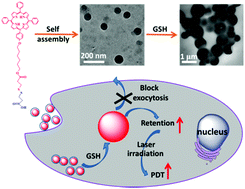GSH-triggered size increase of porphyrin-containing nanosystems for enhanced retention and photodynamic activity†
Abstract
Long retention of therapeutic agents in tumors is imperative for improving the therapeutic index. In this work, the GSH responsive porphyrin molecule (TPP 1) was synthesized, which is amphiphilic and linked by a disulfide bond. TPP 1 molecules could self-assemble into nanoparticles (TPP 1 NPs) with a size of about 100 nm in aqueous solution. The TPP 1 NPs exhibited high stability under different conditions and could form into large microparticles in the presence of glutathione (GSH). The TPP 1 NPs could be internalized by cancer cells, and they emitted enhanced red fluorescence compared to that of TPP 2 NPs (non-sensitive NPs) when cells were pretreated with GSH. In addition, in vitro MTT assays showed that TPP 1 NPs were biocompatible and could further be used as photosensitizers in nanoparticle formation. The cellular photodynamic activity of TPP 1 NPs was obviously higher than that of TPP 2 NPs, due to the increasing retention of TPP in cancer cells, which will generate more reactive oxygen species in cancer cells under light irradiation. These results highlight the potential of developing stimulus responsive nanoparticles for enhanced retention and improved therapeutic outcome.

- This article is part of the themed collection: Journal of Materials Chemistry B Emerging Investigators


 Please wait while we load your content...
Please wait while we load your content...